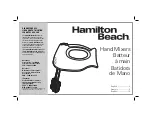
1) MONO MIC/LINE
You can connect balanced, low impedance
microphones or a low level signal to the XLR
socket. On the 1/4" LINE jack you can
connect either a microphone or a line level
instrument, such as synthesizers, drum
machines, effect processors, or any other
line level.
WARNING: Do not connect an unbalanced
microphone to the XLR socket! Doing so
could damage both the mic and the mixer.
Also, it is not possible to simultaneously use
both the MIC & LINE inputs on the same
channel, use only one of them for the
appropriate source.
2) STEREO INPUT
S
These inputs are configured as stereo
pairs using 1/4" balanced TRS jacks. Use
the left channel if connecting a mono
signal.
3) INSERT JACKS
Each of these jacks provides an insert point between the equalizer and level
control of the corresponding input channel
.
The INSERT jacks can be used to
independently connect devices, such as graphic equalizers, compressors, or noise
filters, into the corresponding channels.
These are unbalanced 1/4" TRS jacks that
carry both the send and return signals.
5) LOW
CUT
By pressing this button you will activate a 75Hz low frequency filter with a slope of
18dB per octave.
You can use this feature to reduce AC line induced hum/noise or
stage rumble when using a microphone.
6) COMP
CONTROL
Adjusts the amount of compression applied to the channel. Turn the knob to the
right to
increase the compression. The output gain will automatically adjusted.
The result is smoother, more even dynamics
because the louder signals are
attenuated, while the overall level is boosted.
4) GAIN CONTROL
Adjusts the input signal level.
Turn the knob clockwise to increase the gain; counter-
clockwise to decrease gain.
To achieve the best balance between S/N and dynamic
range, adjust the level so that the peak LED indicator lights occasionally only on the
highest input transients. For mono channels, the MIC input adjustment range of the
Gain is 0 to 50dB and the
sensitivity of the
line input is -35dB to +15 dB;
For stereo
channels,
the MIC adjustment range of the Gain is 0 to 40dB and the
sensitivity of the
line
input is -20dB to +20dB.
LOW CUT
LOW CUT
COMP
0
10
0
15
50dB
35dB
MIC
LINE
0
20
40dB
20dB
MIC
LINE
4)
5)
6)
MIC
4
LINE
INSERT
MIC
5/6
L(MONO)
R
1)
2)
3)
40) AUX
SENDS
This 1/4" TS jack is used to send the signal
out from the AUX bus to external devices,
such as effects.
41) GR1/2
OUT
These 1/4" TRS jacks are used to send out
the signal from the GR 1 / 2 mix bus to
external devices.
42) PHONES
This socket is used to send the mix signal out to a
pair of headphones..
43) DFX
SENDS
This 1/4" TS jack is used to send the signal
out from the DFX mix buses to external
devices.
45) POWER
ON
/
OFF
Use this switch to power the mixer on/off.
44) AC
INLET
WITH
FUSE
HOLDER
Plug the supplied AC power cord into this
C14 panel connector. The fuse is the
T12AL/AC250V type.
47) AMP
OUTPUT
Connect 4 or 8-ohm speakers to these
powered outputs. You can connect using
2-conductor NL4 speaker twist or 1/4" TS
cables. Both NL4 and 1/4" TS cables are
available from Monoprice. Note that Class
2 wiring may be used.
46) PHANTOM
ON
/
OFF
Use this switch to turn Phantom Power on/
off. When Phantom Power is on the
console pr48V to all six XLR
sockets to power condenser microphones.
Do not use Phantom Power with any
device that does not require it. Doing so
could cause damage to the device and/or
mixer.
MAIN MIX OUTPUT
2TK IN
2TK OUT
L
R
R
R
L(MONO)
L
GR2 OUT
L
DFX SENDS
PHONES
AUX SENDS
MAIN MIX
GR1 OUT
CTRL.
ST RETURNS
R
FOOT SW
L
R
35)
36)
37)
38)
39)
40)
41)
42)
43)
44)
ON
OFF
+48V
Use only with a 250V fuse
45)
46)
R
L
MAX. OUTPUT:2X 500W@ 4Ohms 2X 300W@ 8Ohms
MIN.LOAD:4 Ohms CLASS 2 WIRING MAY BE USED
47)
6
11
Summary of Contents for 604570
Page 1: ...604570 1000 watt 12 Channel Powered Mixer with DSP...
Page 2: ...2...


























